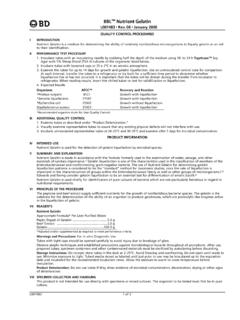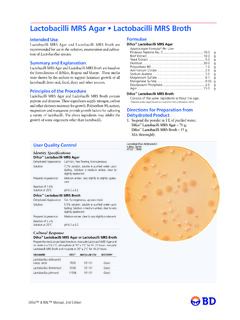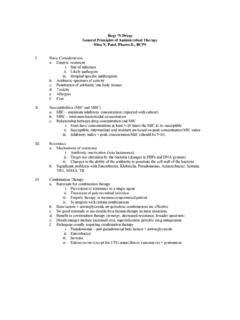Transcription of BD BBL Enterotube
1 INSTRUCTIONS FOR USE BBL Enterotube II Rev.: Jan. 2007 - 1 - BD BBL Enterotube II INTENDED USE BBL Enterotube II is a ready-to-use identification system for the identification of Enterobacteriaceae and a variety of other oxidase negative Gram negative rods. PRINCIPLES AND EXPLANATION OF THE PROCEDURE Microbiological method. Enterobacteriaceae play a major role as infectious agents. This group of bacteria utilizes carbohydrates principally by fermentation and by oxidation. They are catalase positive and nearly all of them are oxidase negative [It has been proposed recently to include Plesiomonas shigelloides into the Enterobacteriaceae based on 16S rRNA sequencing and because it contains the enterobacterial common ,2 Previously, this organism which is is oxidase positive, was included into the family Vibrionaceae]. The identification of Enterobacteriaceae is based on biochemical reactions as described by Ewing and by Farmer.
2 For details, consult the While a huge variety of genera and species has been described over the years, the organisms that are isolated from clinical specimens belong to 20 to 25 species that are well-known for many BBL Enterotube II is a self-contained, compartmented plastic tube containing twelve different media that allow the determination of 15 biochemical reactions (glucose, gas production from glucose, lysine decarboxylase, ornithine decarboxylase, hydrogen sulfide (H2S), indole, adonitol, lactose, arabinose, sorbitol, Voges-Proskauer (VP), dulcitol, phenylalanine deaminase (PA), urea and citrate). The enclosed inoculating wire allows inoculation of all compartments in one step from one or a few single colonies of an isolate. The resulting combination of reactions, together with the Interpretation Guide (codebook), allow identification of clinically significant Enterobacteriaceae.
3 The Interpretation Guide (codebook) for BBL Enterotube II was constructed using the percentage data contained in the references for the biochemical tests performed by BBL Enterotube The Results Pad and Color Reaction Chart permit a rapid check of the positive reactions obtained with BBL Enterotube II. The checked positive numbers are totaled, and the composite number is then located in the Interpretation Guide to identify the organisms. Where two or more organisms are listed, the confirmatory tests required to further identify them are also given. The following flow diagram demonstrates how the oxidase test may used to differentiate members of the family Enterobacteriaceae from nonfermentative, oxidase positive or negative, and from fermentative, oxidase positive Gram negative bacteria and when BBL Enterotube II or BBL Oxi/Ferm Tube II are used: Pure culture on nonselective medium Oxidase test positive negative Inoculate BBL Oxi/Ferm Tube II Inoculate BBL Enterotube II Anaerobic glucose Glucose Positive Negative Positive Negative* Aeromonas spp.
4 , Plesiomonas shigelloides, Vibrio spp. Achromobacter spp., Alcaligenes spp., Bordetella bronchiseptica, Moraxella spp., Pasteurella spp., etc. Enterobacteriaceae Acinetobacter spp., stenotrophomonas maltophilia, etc. * These species may be identified with the BBL Enterotube II system, but use of BBL Oxi/Ferm Tube II may be necessary for confirmation. REAGENTS BBL Enterotube II Substrates, other active ingredients, and coloration of the uninoculated media: - 2 - Medium 1 (Glucose): Glucose ( g/l) contained in an appropriate base medium, with cresol red as a pH indicator. The medium is covered with wax to provide anaerobic conditions and to allow detection of gas formation. Uninoculated: red. Medium 2 (Lysine): Lysine ( g/l) contained in an appropriate base medium, with bromcresol purple as a pH indicator. The medium is covered with wax to provide anaerobic conditions.
5 Uninoculated: yellow. Medium 3 (Ornithine): Ornithine ( g/l) contained in an appropriate base medium, with bromcresol purple as a pH indicator. The medium is covered with wax to provide anaerobic conditions. Uninoculated: yellow. Medium 4 (H2S/Indole): Sodium thiosulfate ( g/l) , ferric ammonium citrate ( g/l) , and tryptophan ( g/l) in an appropriate base medium. Uninoculated: Beige to light amber. Medium 5 (Adonitol): Adonitol ( g/l) contained in an appropriate base medium, with cresol red as a pH indicator. Uninoculated: red. Medium 6 (Lactose): Lactose ( g/l) contained in an appropriate base medium, with cresol red as a pH indicator. Uninoculated: red. Medium 7 (Arabinose): Arabinose ( g/l) contained in an appropriate base medium, with cresol red as a pH indicator. Uninoculated: red. Medium 8 (Sorbitol): Sorbitol (20 g/l) contained in an appropriate base medium, with cresol red as a pH indicator.
6 Uninoculated: red. Medium 9 (Voges-Proskauer): Glucose ( g/l) contained in an appropriate base medium. Uninoculated: colorless to light amber. Medium 10 (Dulcitol/PA): Dulcitol ( g/l) , phenylalanine ( g/l), and ferric ammonium citrate ( g/l) contained in an appropriate base medium, with bromthymol blue as a pH indicator. Uninoculated: green. Medium 11 (Urea): Urea ( g/l) contained in an appropriate base medium, with phenol red as a pH indicator. Uninoculated: beige to light amber. Medium 12 (Citrate): Sodium citrate ( g/l) contained in an appropriate base medium, with bromthymol blue as a pH indicator. Uninoculated: green. PRECAUTIONS . For professional use only Do not use tubes if they show evidence of microbial contamination, discoloration, wax detachment from the respective media, drying, cracking or other signs of deterioration.
7 Any of the following conditions may interfere with the accuracy of BBL Enterotube II: dehydration or liquefaction, lifting of wax from media surfaces, any change of media colors from those indicated under Uninoculated in the REAGENTS section, and any indication of growth on media surfaces. The following precautions pertain to the individual compartments indicated: Glucose: The wax overlay in this compartment produces the degree of anaerobiosis necessary to allow only the true fermentation reaction characteristic of all Enterobacteriaceae. If this medium remains red after inoculation and incubation, the strain does not belong to the Enterobacteriaceae. Examples of oxidase-negative non-Enterobacteriaceae that fail to ferment glucose under anaerobic conditions in BBL Enterotube II are glucose negative Acinetobacter species. Although these organisms can be differentiated from Enterobacteriaceae using BBL Enterotube II (in the Interpretation Guide, use the database for the oxidase negative nonfermenters), BBL Oxi/Ferm Tube II may be required for their further identification.
8 Phenylalanine (PA): The medium may become a deeper shade of green after incubation. This should be considered negative. Warning: When preparing and handling indole and VP reagents, observe appropriate handling instructions and Risk and Safety Phrases. Consult GENERAL INSTRUCTIONS FOR USE document for aseptic handling procedures, biohazards, and disposal of used product. STORAGE AND SHELF LIFE On receipt, store BBL Enterotube II in the dark at 2 to 8 C, in the original box until just prior to use. Avoid freezing and overheating. The tubes may be inoculated up to the expiration date and incubated for the recommended incubation times. Tubes from opened packages can be used up to the expiration date. Opened tubes must be used immediately. - 3 - USER QUALITY CONTROL Inoculate BBL Enterotube II with the strains mentioned below. For inoculation, incubation, and reading, proceed as described in Test Procedure.
9 ORGANISMS Glucose Gas Lysine Ornithine H2S Indole Adonitol Lactose Arabinose Sorbitol VP Dulcitol Phenyl-alanine Urea Citrate Acceptable biocodes Proteus mirabilis ATCC 12453 + +/- - + + - - - - - - - + + +/- 66007 / 66006 / 46007 Proteus vulgaris ATCC 6380 +/(+) +/- - - + + - - - - - - + + + 63007 / 43007 Providencia alcali-faciens ATCC 9886 + +/- - - - + + - - - - - + - -/+ 61404 / 41405 / 41404 / 61405 Serratia marcescens ATCC 13880 + +/- + + - - +/-- - + + - - - + 74461 / 54461 / 74061 / 54061 Escherichia coli ATCC 25922 + +/- + + - + - + + + - - - - - 75340 / 55340 Klebsiella pneumoniae ATCC 27736 + +/- + - - - + + + + + + - -/+ + 50771 / 70771 / 70773 / 50773 Pseudomonas aeruginosa ATCC 27853.
10 - - - - -/+- - - - -/(+) + * * P. aeruginosa is oxidase positive and is, therefore, not included in the BBL Enterotube II databases. However, this strain is useful as a control organism to detect negative reactions in the glucose and gas compartments. += positive; = negative; (+) weakly positive; +/- = positive or (rarely) negative; +/(+) = positive or (rarely) weakly positive; -/+= negative or (rarely) positive. PROCEDURE Materials Provided BBL Enterotube II. Microbiologically controlled. Results Pad and Color Reaction Chart for BBL Enterotube II. Materials Not Provided BBL Enterotube II Interpretation Guide (codebook), document no. , which is divided into three databases: (1) Oxidase negative nonfermenters, (2) Enterobacteriaceae method without VP, and (3) Enterobacteriaceae method with VP. Kovacs indole reagent (Indole Dropper Reagent, 50 ampoules, cat.)















